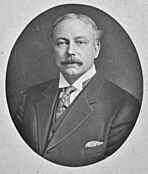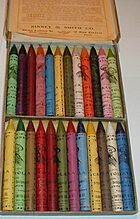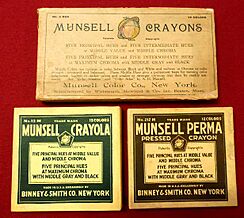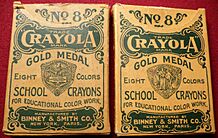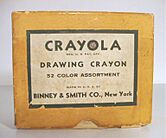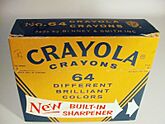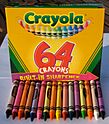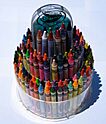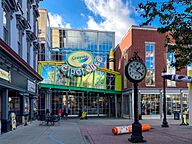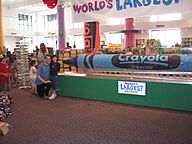Crayola facts for kids
 |
|
|
Formerly
|
Binney & Smith Company (1885–2007) |
|---|---|
| Subsidiary | |
| Traded as | NYSE: Private |
| Industry | Art materials |
| Founded | June 25, 1885 |
| Founders |
|
| Headquarters |
Forks Township, Pennsylvania
,
U.S.
|
|
Number of locations
|
11 |
|
Area served
|
Worldwide |
|
Key people
|
|
| Products |
|
| Brands |
|
|
Number of employees
|
2,000 (2018) |
| Parent | Hallmark Cards (1984–present) |
Crayola LLC, once known as the Binney & Smith Company, is an American company that makes and sells art supplies. It is famous for its Crayola brand, especially its crayons. The company's main office is in Forks Township, Pennsylvania, in the Lehigh Valley area. Since 1984, Crayola has been owned by Hallmark Cards.
Crayola started out making colors for industrial use. But soon, it began focusing on art products for homes and schools. They first made chalk, then crayons, and later added colored pencils, markers, paints, modeling clay, and other art items. All Crayola products are made to be nontoxic, meaning they are safe for children to use. Most Crayola crayons are made in the United States.
Crayola also makes Silly Putty and a special line of art products for artists called 'Portfolio Series'. These include acrylics, watercolor paints, and brushes. Crayola says that 99% of homes in the U.S. know the Crayola brand. Its products are sold in over 80 countries around the world.
Contents
History of Crayola
The Crayola company was started by Edwin Binney and Harold Smith. At first, they made colors for factories, like red iron oxide for barn paint and carbon black for making tires black. In 1900, their special black color won a gold medal at the Paris Exposition. That same year, they started making slate school pencils. Edwin Binney also invented the first dustless white chalk, which won another gold medal in 1904.
Binney & Smith became a corporation in 1902. In 1903, Edwin Binney and his wife, Alice Stead Binney, created their famous wax crayons. Alice, a former teacher, came up with the name Crayola. It combines craie (French for "chalk") and ola (meaning "oily"). The "-ola" ending was popular for product names back then. Crayola launched a whole line of crayons, not just one box. By 1905, they had 18 different crayon boxes with various sizes and colors.
The Rubens Crayola line, started in 1903, was made for artists. These crayons were designed to compete with European brands. Boxes ranged from five cents for a small box to $1.50 for a large artist's set.
In April 1904, Binney & Smith won a gold medal for their dustless chalk at the St. Louis World's Fair. Crayola then started putting this gold medal on their crayon boxes. This made their brand very famous, and the gold medal design stayed on their packaging for over 50 years.
In 1926, Binney & Smith bought the Munsell Color Company's crayon line. This added 22 new colors to their collection. By 1939, Crayola combined its colors with the Munsell colors to create its largest box yet: a "No. 52 Drawing Crayon 52 Color Assortment."
In 1949, Crayola introduced the "Crayola No. 48" box with 48 colors. A big step happened in 1958 with the 64-color pack. This box was special because it had the company's first built-in crayon sharpener. The 64-color box is seen as a very important moment in Crayola's history.
In 1963, the company became a public company, meaning people could buy shares in it. In 1977, Binney & Smith bought the rights to Silly Putty, a fun, stretchy toy. Crayola markers were launched in 1978, celebrating 75 years of Crayola crayons. In 1984, Hallmark Cards bought the company. Colored pencils and washable markers were added in 1987.
In 1998, Crayola Crayons were added to the National Toy Hall of Fame. On January 1, 2007, Binney & Smith changed its name to Crayola LLC. This new name showed that Crayola was their most important brand. In 2011, "My First Crayola" products were launched for very young children. In 2015, Crayola released "Color Escapes" for adults to help them relax.
Crayola Crayons
Crayola crayon packs come in many sizes. Some small packs are given out at hotels and restaurants for young guests. There are also huge "Classpack" boxes with 832 crayons for schools. The number of colors in a pack can range from just a few to 200. The 200-color packs include special crayons like glitter or neon colors.
The most common packs sold in stores have colors in groups of eight. You can find packs with 8, 16, 24, 32, 48, 64, 96, and 120 crayons today. In 2006, a 150-crayon pack came out in a cool plastic tower case. It had 118 regular colors, 16 glitter crayons, and 16 "Metallic FX" crayons. It even had a sharpener built into the top. This was followed by a 152-crayon set in 2013.
Crayon Colors
As Crayola crayon packs grew, so did the number of colors. By 1998, there were 120 colors. Since then, new colors have been added, but they usually replace older ones. For example, on March 31, 2017, Crayola announced that the color Dandelion would be retired. On September 14, 2017, a new color called "Bluetiful" was announced to replace it. This color was discovered by scientists experimenting with electronics.
In 2021, Crayola introduced four new colors with their "Colors of Kindness" pack. So far, 14 colors have been officially retired. This means Crayola has produced a total of 138 regular colors over time. Crayola currently makes 120 standard crayon colors. These are all found in the regular 120-count box. This number does not include special crayons like Metallic FX or glitter crayons.
Colors Chart
The colors in the table below are found in the 8, 16, and 24-count packs:
| 8 pack (as of 1903) | +8 = 16 pack (as of 1930) | +8 = 24 pack (until October 2017) | |||
|---|---|---|---|---|---|
Red |
Orange |
Carnation Pink |
Red Orange |
Violet Red |
Scarlet |
Yellow |
Green |
Yellow Orange |
Yellow Green |
Green Yellow |
Cerulean |
Blue |
Violet (Purple) |
Blue Green |
Blue Violet |
Dandelion |
Indigo |
Brown |
Black |
Red Violet |
White |
Apricot |
Gray |
In 2020, Crayola launched a new line of 24 colors called "Colors of the World." These crayons were made to match nearly 40 different skin tones from people around the globe. The box had a special label showing skin tone gradients. For the first time, the color names were written in French, English, and Spanish.
Crayola's Cultural Impact
The Smithsonian National Museum of American History has a collection of Crayola crayons. It started in 1998 with an original 64-color box. Now, the collection has over 300 boxes of crayons. The Crayola crayon was one of the first items to be added to the National Toy Hall of Fame.
Crayola has been shown on popular children's TV shows like Sesame Street and Mister Rogers' Neighborhood. In February 1996, Fred Rogers himself helped mold the 100 billionth crayon at the Crayola factory.
Commemorative Postage Stamp
In 1998, the United States Postal Service released a 32-cent postage stamp. This stamp honored how important Crayola products have been to almost all Americans. The stamp was part of the "Celebrate the Century" series.
Crayola Color Census 2000
In 2000, Crayola held a special event called the "Crayola Color Census 2000." Americans were asked to vote for their favorite Crayola crayon color. Famous people like George W. Bush chose "Blue Bell," and Tiger Woods picked "Wild Strawberry." Overall, "Blue" was the most popular color, followed by "Cerulean" and "Purple Heart."
Crayola Experience Centers
The Crayola Experience is a fun place where visitors can learn about crayons. It started as the Crayola Factory in Easton, Pennsylvania. It's a large, colorful warehouse with activities, a store, and exhibits about Crayola's history.
There is a "discovery center" that shows how crayons are made. There is also a "Crayola Hall of Fame" where retired crayon colors are displayed.
On October 11, 2003, the Crayola Experience showed off "The World's Largest Crayon." This crayon was 15 feet long and weighed 1,500 pounds! It was made from 123,000 used or broken blue crayons sent in by children across the U.S. This was part of the celebration for 100 years of Crayola crayons.
The Crayola Experience has grown and now has several locations. The first opened in Easton, Pennsylvania, in May 2013. Other locations include Orlando, Florida (June 2015), Bloomington, Minnesota (February 2016), Plano, Texas (March 2018), and Chandler, Arizona (May 2019). A sixth location is planned to open in Pigeon Forge, Tennessee, in 2025.
Crayons in Fine Art
Even though Crayola crayons are made for kids and hobby artists, some professional artists use them in their work. Don Marco is a well-known crayon artist. He uses Crayola crayons and construction paper to create his art. He has sold over a million prints of his original artworks.
Other Crayola Products
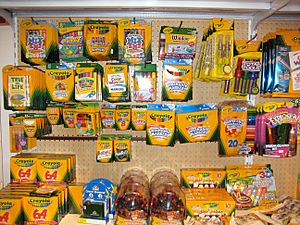
Crayola LLC makes many products besides its famous crayons. These include colored pencils, markers, inks, paints, modeling clays, coloring books, and art tools. Like all Crayola products, these are also made to be non-toxic and safe for children.
Other Crayola Brands
Silly Putty
Silly Putty is a stretchy, bouncy toy made from a special material called silicone. It can be used for many fun things. Silly Putty was added to the National Toy Hall of Fame in 2001.
Portfolio Series
The Portfolio Series is a line of art supplies for artists and teachers. It includes water-soluble oil pastels, watercolors, drawing pencils, colored pencils, and acrylic paints.
Silly Scents
Silly Scents is a fun line of Crayola products that smell good! It includes scented crayons, markers, colored pencils, clay, and paint.
Staonal
Staonal is a type of crayon made for general use, not just coloring. It was first developed in 1902 and is still made today.
Scribble Scrubbie Pets
Scribble Scrubbie Pets are toy animal figures that kids can draw on with washable markers. You can also play with "digital pets" using the Scribble Scrubbie Pets App.
Crayola Studios
On August 3, 2023, Crayola started a new part of its company called Crayola Studios. This studio will create movies and shows for kids and families.
Crayola Licensing
Many other companies make products using the Crayola brand name. These products can be anything from bath items to bedding and electronics. For example, Firebrand Games made a Crayola-themed video game called Crayola Treasure Adventures for Nintendo DS in 2007. Another game, Crayola Scoot, was released in 2018 for various gaming systems.
In 2021, Kellogg's and Crayola worked together to create a fruit-flavored cereal. The cereal box even had a coloring book on it! The Kellogg's Crayola Jazzberry Cereal had rainbow-colored corn puffs. The package also gave access to a digital pet in the Scribble Scrubbie Pets App.
Crayola Manufacturing
Crayola has factories in Forks Township, Pennsylvania, and Bethlehem, Pennsylvania, in the U.S. They also have plants in Lindsay, Ontario, Canada, and Mexico City, Mexico. Some of their colored pencils are made by Faber-Castell in Brazil.
See also
 In Spanish: Crayola para niños
In Spanish: Crayola para niños


